Contents:
- Undisturbed mass nesting of Olive Ridleys at Rushikulya
- White House, Congress agree on $2 trillion virus rescue Bill
- Saudi King to chair G20 virtual summit
- Finance Ministry writes to RBI for relaxing farm loan NPA norms
- Union Cabinet approves recapitalisation of RRBs
UNDISTURBED MASS NESTING OF OLIVE RIDLEYS AT RUSHIKULYA
Focus: GS-III Environment and Ecology
Why in news?
Restrictions in place for the COVID-19 threat is saving lakhs of Olive Ridley turtles from possible intrusion by humans, especially tourists, while they are continuing mass nesting at Odisha’s Rushikulya rookery.
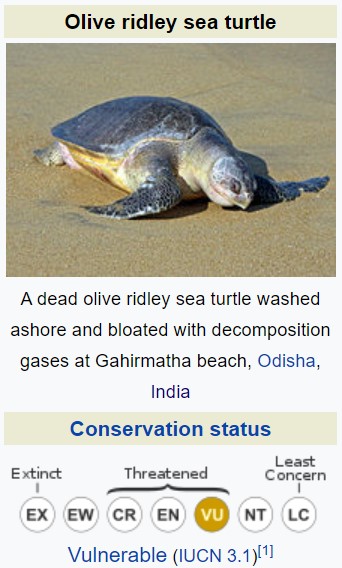
What is different this year?
- This event normally attracts hundreds of people to the spot, with Forest Department personnel spending considerable time and effort in controlling the crowds of tourists as well as locals. But this year, the COVID-19 lockdown has ensured no such disturbance occurs for the turtles.
- Two trawlers, two speed boats and a country boat are being used by Forest Department to patrol the sea, in order to prevent fishing trawlers from plying along the coast. Trawlers did not cause any deaths of turtles as a result.
- This year, the beach has received thorough cleaning at regular cleaning long before mass nesting commenced. The Forest Department also set up 11 off-shore camps early this year to monitor the beach.
Disruptions in Nesting in the Past
- In 2019, mass nesting of Olive Ridleys did not occur in Rushikulya, in contrast to 2018, when “double mass nesting” occurred in February and April, with nesting figures rising above 4,73,000.
- October 2018’s Cyclone Titli, and the floods that followed, left huge piles of waste over about 8 km of the Rushikulya coast, which had to be cleaned with excavators. It has been estimated that minute particles of the waste had remained, keeping the nesting Olive Ridleys away in 2019.
Olive Ridley Sea Turtle
- The olive ridley sea turtle (Lepidochelys olivacea), also known commonly as the Pacific ridley sea turtle, is a species of turtle in the family Cheloniidae.
- The species is the second smallest and most abundant of all sea turtles found in the world.
- This turtle and the related Kemps ridley turtle are best known for their unique mass nesting called arribada, where thousands of females come together on the same beach to lay eggs.
- The species is listed as Vulnerable in the IUCN Red List, Appendix 1 in CITES, and Schedule 1 in Wildlife Protection Act, 1972.
- Olive-ridleys face serious threats across their migratory route, habitat and nesting beaches, due to human activities such as unfriendly turtle fishing practices, development, and exploitation of nesting beaches for ports, and tourist centres.
Breeding Grounds of the Olive Ridley Sea Turtle in India
- The Gahirmatha Beach in Kendrapara district of Odisha (India), which is now a part of the Bhitarkanika Wildlife Sanctuary, is the largest breeding ground for these turtles.
- The Gahirmatha Marine Wildlife Sanctuary, which bounds the Bhitarkanika Wildlife Sanctuary to the east, was created in September 1997, and encompasses Gahirmatha Beach and an adjacent portion of the Bay of Bengal.
- Bhitarkanika mangroves were designated a Ramsar Wetland of International Importance in 2002. It is the world’s largest known rookery of olive ridley sea turtles.
- Apart from Gahirmatha rookery, two other mass nesting beaches have been located, which are on the mouth of rivers Rushikulya and Devi.
- The spectacular site of mass congregation of olive ridley sea turtles for mating and nesting enthralls both the scientists and the nature lovers throughout the world.
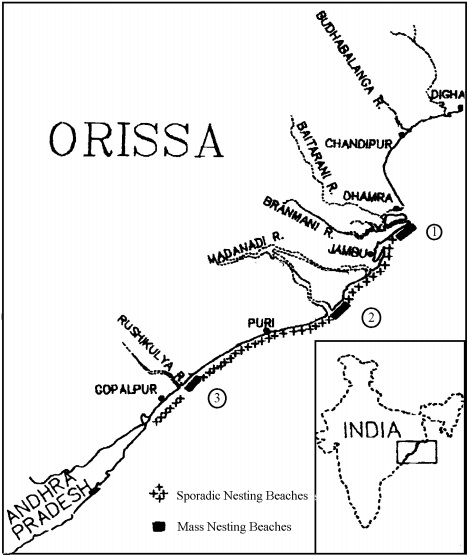
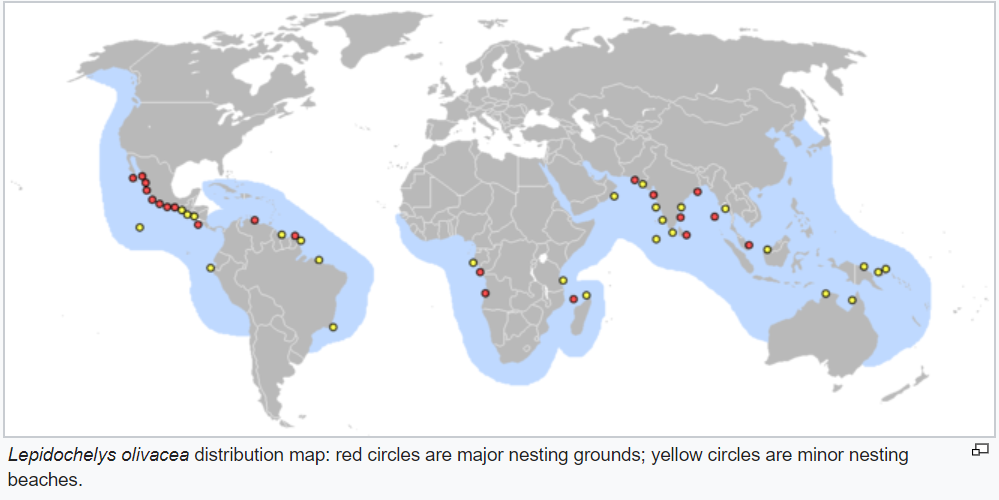
Threats to the Olive Ridley Sea Turtle
- Known predators of olive ridley eggs include raccoons, coyotes, feral dogs and pigs, opossums, coatimundi, caimans, ghost crabs, and the sunbeam snake.
- Hatchlings are preyed upon as they travel across the beach to the water by vultures, frigate birds, crabs, raccoons, coyotes, iguanas, and snakes. In the water, hatchling predators most likely include oceanic fishes, sharks, and crocodiles.
- Adults have relatively few known predators, other than sharks, and killer whales are responsible for occasional attacks. On land, nesting females may be attacked by jaguars. Notably, the jaguar is the only cat with a strong enough bite to penetrate a sea turtle’s shell, thought to be an evolutionary adaption from the Holocene extinction event.
- In recent years, increased predation on turtles by jaguars has been noted, perhaps due to habitat loss and fewer alternative food sources. Sea turtles are comparatively defenseless in this situation, as they cannot pull their heads into their shells like freshwater and terrestrial turtles.
- Humans are still listed as the leading threat to L. olivacea, responsible for unsustainable egg collection, slaughtering nesting females on the beach, and direct harvesting adults at sea for commercial sale of both the meat and hides.
Bhitarkanika National Park
- Bhitarkanika National Park is one of Odisha’s finest biodiversity hotspots and is famous for its mangroves, migratory birds, turtles, estuarine crocodiles, and countless creeks.
- The wetland is represented by 3 Protected Areas, the Bhitarkanika National Park, the Bhitarkanika Wildlife Sanctuary and the Gahirmatha Marine Sanctuary.
- Bhitarkanika is located in the estuary of Brahmani, Baitarani, Dhamra, and Mahanadi river systems.
- It is said to house 70% of the country’s estuarine or saltwater crocodiles, conservation of which was started way back in 1975.
Extra Information
- Kemp’s ridley turtle is the smallest of the sea turtles, with adults reaching a maximum of 75 cm (30 in) in carapace length and weighing a maximum of 50 kg (110 lb).
- The olive ridley is predominantly carnivorous, especially in immature stages of the lifecycle.
- Animal prey consists of protochordates or invertebrates, which can be caught in shallow marine waters or estuarine habitats. Common prey items include jellyfish, tunicates, sea urchins, bryozoans, bivalves, snails, shrimp, crabs, rock lobsters, and sipunculid worms.
WHITE HOUSE, CONGRESS AGREE ON $2 TRILLION VIRUS RESCUE BILL
Focus: GS-III Disaster Management, Economic Development
Why in news?
- The White House and Senate leaders of both parties announced agreement early 25th March on unprecedented emergency legislation to rush sweeping aid to businesses, workers and a health care system slammed by the coronavirus pandemic.
- The urgently needed pandemic response measure is the largest economic rescue measure in history and is intended as a weeks- or months-long patch for an economy spiraling into recession and a nation facing a potentially ghastly toll.
Expected Outcomes
- The unprecedented economic rescue package would give direct payments to most Americans, expand unemployment benefits and provide a $367 billion program for small businesses to keep making payroll while workers are forced to stay home.
- It will rush new resources onto the front lines of our nation’s health care fight.
- It will inject trillions of dollars of cash into the economy as fast as possible to help Americans workers, families, small businesses and industries make it through this disruption and emerge on the other side ready to soar.
- The unprecedented economic rescue package would give direct a one-time payment of $1,200 per adult and $500 per child directly to the public.
- It ensures that all workers are protected whether they work for businesses small, medium or large, along with self-employed and workers in the gig economy.
SAUDI KING TO CHAIR G20 VIRTUAL SUMMIT
Focus: GS-III International Relations, Prelims
Why in news?
- Leaders of the G20 group of nations will hold a video conference on 26th March 2020.
- The virtual summit will be led by King Salman bin Abdulaziz al Saud of Saudi Arabia which is the current president of the economic grouping.
Details
- G20 members will be joined by leaders from invited countries, Spain, Jordan, Singapore, and Switzerland as well as international organisations, the United Nations, the World Bank Group, the World Health Organisation and the World Trade Organisation, the Food and Agriculture Organisation, the International Monetary Fund, the Organisation for Economic Cooperation and Development
- Apart from 19 of the biggest economies of the world, G20 also includes the European Union. For 2020, Spain, Jordan Singapore and Switzerland are the invited countries.
- For Prime Minister Narendra Modi, this will be the second virtual leadership summit after the video summit of the South Asian Association for Regional Cooperation (SAARC) that he had initiated.
- The SAARC virtual summit held on March 15 led to the creation of the SAARC COVID-19 Emergency Fund.
- It is expected that the G20 virtual summit will yield a detailed plan for confronting the pandemic caused by the novel coronavirus known as COVID-19.
Introduction to G20
- The G20 (or Group of Twenty) is an international forum for the governments and central bank governors from 19 countries and the European Union (EU).
- Founded in 1999 with the aim to discuss policy pertaining to the promotion of international financial stability, the G20 has expanded its agenda since 2008 and heads of government or heads of state, as well as finance ministers and foreign ministers, have periodically conferred at summits ever since.
- It seeks to address issues that go beyond the responsibilities of any one organization.
Members of G20
- Membership of the G20 consists of 19 individual countries plus the European Union.
- The EU is represented by the European Commission and by the European Central Bank.
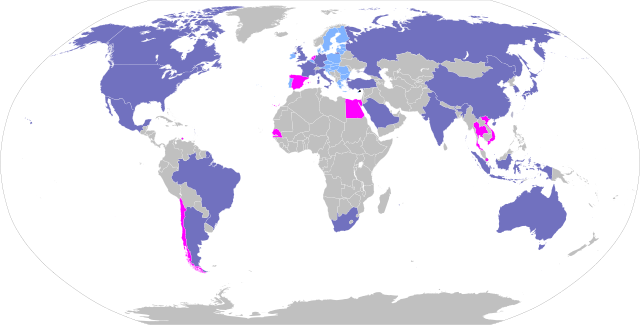
- As of 2017 there are 20 members of the group: Argentina, Australia, Brazil, Canada, China, the European Union, France, Germany, India, Indonesia, Italy, Japan, Mexico, Russia, Saudi Arabia, South Africa, South Korea, Turkey, the United Kingdom, and the United States. Spain is a permanent guest invitee.
- Collectively, the G20 economies account for around 90% of the gross world product (GWP), 80% of world trade (or, if excluding EU intra-trade, 75%), two-thirds of the world population, and approximately half of the world land area.
Structure and Functioning of G20
- The G20 Presidency rotates annually according to a system that ensures a regional balance over time.
- For the selection of presidency, the 19 countries are divided into 5 groups, each having no more than 4 countries. The presidency rotates between each group. Every year the G20 selects a country from another group to be president.
- India is in Group 2 which also has Russia, South Africa, and Turkey.
- The G20 does not have a permanent secretariat or Headquarters. Instead, the G20 president is responsible for bringing together the G20 agenda in consultation with other members and in response to developments in the global economy.
- TROIKA: Every year when a new country takes on the presidency (in this case Argentina 2018), it works hand in hand with the previous presidency (Germany, 2017) and the next presidency (Japan, 2019) and this is collectively known as TROIKA. This ensures continuity and consistency of the group’s agenda.
Note: Not to be confused with G20 Developing Nations
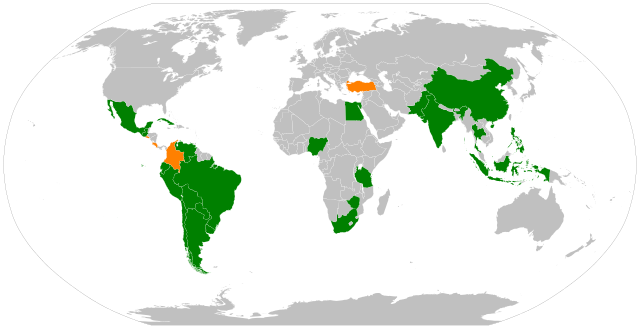
- The G20 developing nations (and, occasionally, the G21, G23 or G20+) is a bloc of developing nations established on 20 August 2003.
- Distinct and separate from the G20 major economies, the group emerged at the 5th Ministerial WTO conference, held in Cancún, Mexico, from 10 September to 14 September 2003.
- The group accounted for 60% of the world’s population, 70% of its farmers and 26% of world’s agricultural exports.
FINANCE MINISTRY WRITES TO RBI FOR RELAXING FARM LOAN NPA NORMS
Focus: GS-III Indian Economy, Economic Development
Why in news?
The Finance Ministry has asked the Reserve Bank of India (RBI) to relax asset classification norms for farm loans extended by banks following the stress faced by the agriculture sector.
What did the Ministries and Departments say?
- Finance Ministry requested to consider making appropriate relaxation in asset classification norms in respect of short-term agricultural crop loans for a period up to 30th June 2020.
- The Department of Agriculture, Cooperation and Farmers’ Welfare, Government of India, said that in view of the unprecedented situation prevailing in the country on account of increasing incidence of COVID-19 infection and consequent lockdown across the country, they are actively considering the possibility of extending the benefit of interest subvention and prompt repayment incentive to short-term crop agriculture loans falling due between 29th March 2020 and 30th June 2020, if the loans are repaid by 30th June 2020.
- They have further stated the extension of the repayment date would require relaxation in asset qualification by RBI.
Background
- The spread of COVID-19 has resulted in a lockdown across the country with economic and other activities coming to a grinding halt.
- As a result, industry and bankers have demanded a relaxation in bad loan norms, apart from economic stimulus from the government.
- A task force headed by finance minister Nirmala Sithararam has been formed to finalise an economic relied package.
What Is a Non-Performing Asset (NPA)?
- A nonperforming asset (NPA) refers to a classification for loans or advances that are in default or in arrears.
- A loan is in arrears when principal or interest payments are late or missed.
- A loan is in default when the lender considers the loan agreement to be broken and the debtor is unable to meet his obligations.
How do Non-Performing Assets (NPA) Work?
- Nonperforming assets are listed on the balance sheet of a bank or other financial institution.
- After a prolonged period of non-payment, the lender will force the borrower to liquidate any assets that were pledged as part of the debt agreement.
- If no assets were pledged, the lender might write-off the asset as a bad debt and then sell it at a discount to a collection agency.
UNION CABINET APPROVES RECAPITALISATION OF RRBs
Focus: GS-III Indian Economy
Why in news?
- The Centre has approved a ₹1,340-crore recapitalisation plan for regional rural banks (RRBs) to improve their Capital-to-Risk weighted Assets Ratio (CRAR), strengthening these institutions that are critical to the provision of credit in rural areas.
- On 25th march 2020, the Cabinet Committee on Economic Affairs gave its nod for an outlay of ₹670 crore as the central share for the scheme on the condition that the release of the funds will be contingent upon the release of the proportionate share by the sponsor banks, an official statement said.
Details
- This would provide minimum regulatory capital for one more year viz. up to 2020-21 for those RRBs that are unable to maintain the minimum CRAR of 9%. This has been an ongoing scheme since 2011.
- The RRBs are required to provide 75% of their total credit as priority sector lending with primary focus on agricultural credit, including small and marginal farmers, as well as micro entrepreneurs and rural artisans.
- At a time of lockdown due to the COVID-19 crisis, financially stronger rural banks could also be crucial to ensuring liquidity in rural areas.
Regional Rural Bank (RRB)
- Regional Rural Banks (RRBs) are Indian Scheduled Commercial Banks (Government Banks) operating at regional level in different States of India.
- They have been created with a view of serving primarily the rural areas of India with basic banking and financial services.
- However, RRBs may have branches set up for urban operations and their area of operation may include urban areas too.
- The area of operation of RRBs is limited to the area as notified by Government of India covering one or more districts in the State.
RRBs perform various functions in following heads:
- Providing banking facilities to rural and semi-urban areas.
- Carrying out government operations like disbursement of wages of MGNREGA workers, distribution of pensions etc.
- Providing Para-Banking facilities like locker facilities, debit and credit cards, mobile banking, internet banking,UPI etc.
- Small financial banks.
What is CRAR: Capital-to-Risk weighted Assets Ratio?
- Capital to Risk (Weighted) Assets Ratio (CRAR) is also known as Capital adequacy Ratio, the ratio of a bank’s capital to its risk.
- The banking regulator tracks a bank’s CAR to ensure that the bank can absorb a reasonable amount of loss and complies with statutory Capital requirements.
- Higher CRAR indicates a bank is better capitalized.
How is CRAR Calculated?
- The Capital to risk-weighted assets ratio is arrived at by dividing the capital of the bank with aggregated risk-weighted assets for credit risk, market risk, and operational risk.
- The higher the CRAR of a bank the better capitalized it is.
- The capital to risk-weighted assets ratio is calculated by adding a bank’s tier 1 capital and tier 2 capitals and dividing the total by its total risk-weighted assets.
That is:
Tier 1 CRAR =( Eligible Tier 1 capital funds)= (Credit Risk RWA + Market Risk RWA + Operational Risk RWA)
Total CRAR= (Eligible Total capital funds)÷ (Credit Risk RWA + Market Risk RWA + Operational Risk RWA)




